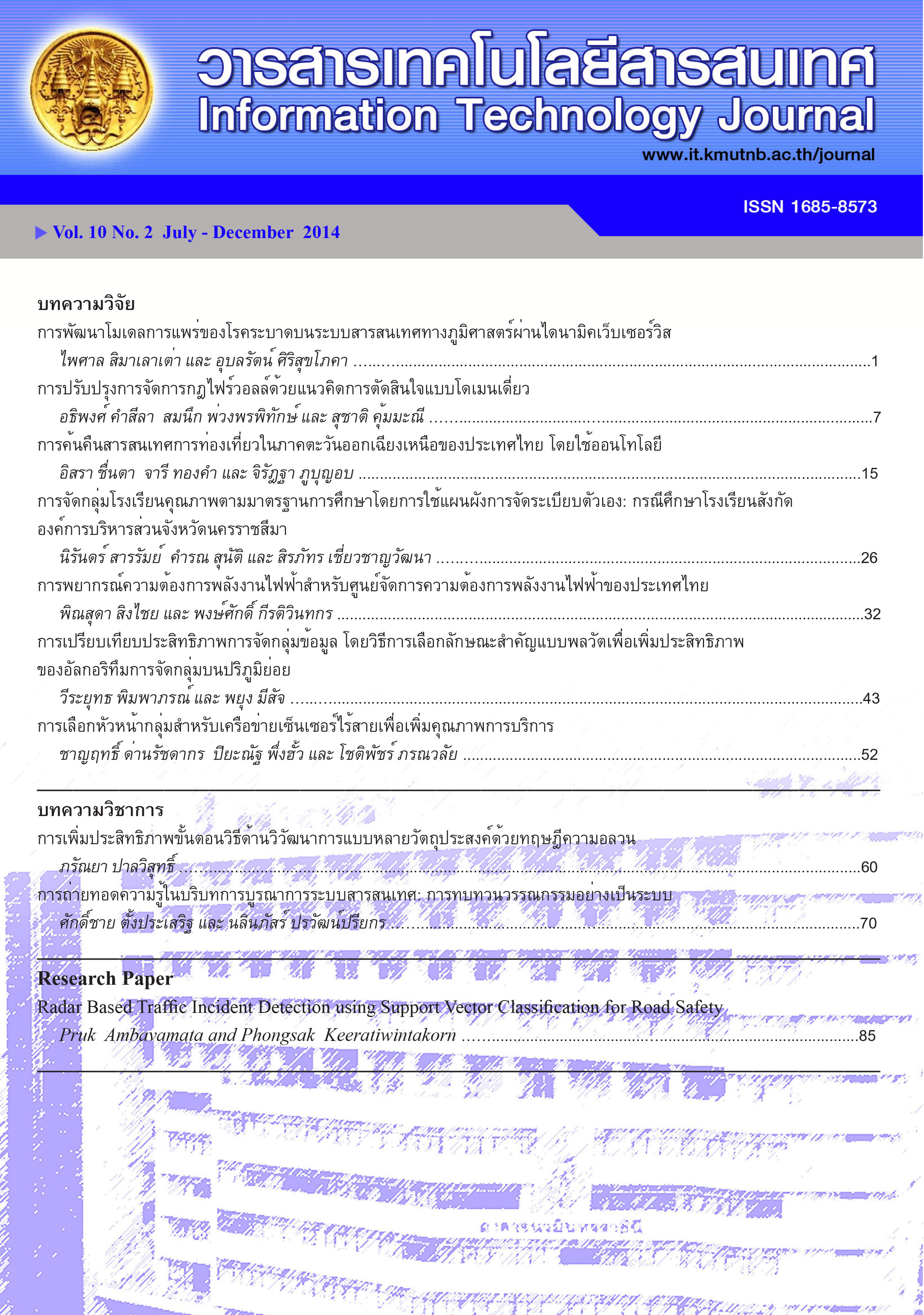การพยากรณ์ความต้องการพลังงานไฟฟ้าสำหรับศูนย์จัดการ ความต้องการพลังงานไฟฟ้าของประเทศไทย
Main Article Content
Abstract
ในปัจจุบันความต้องการพลังงานไฟฟ้าในประเทศไทยนั้น มีความต้องการเพิ่มมากขึ้นตามการเติบโตของกลุ่มโรงงาน อุตสาหกรรม กลุ่มอาคารพาณิชย์ และกลุ่มบ้านพักอาศัย การพยากรณ์ความต้องการพลังงานไฟฟ้าจึงมีบทบาทสำคัญ ต่อการจัดการด้านความต้องการกับการผลิตพลังงานไฟฟ้า ให้สอดคล้องกันเพื่อลดค่าใช้จ่ายในส่วนที่มีการผลิตพลังงาน ไฟฟ้าเกิน การจัดการนี้คือ การจัดการด้านการใช้ไฟฟ้า (Demand Side Management: DSM) ในงานวิจัยนี้ได้เสนอ การพยากรณ์ความต้องการพลังงานไฟฟ้าโดยใช้เทคนิค ซัพพอร์ตเวกเตอร์แมชชีนแบบรีเกรสชัน (Support Vector Machine-Regression: SVM-R) ร่วมกับฟังก์ชันเรเดียลเบซิส (Radial Basis Function: RBF) ซึ่งใช้ข้อมูลของปริมาณการใช้ พลังงานไฟฟ้าราย 1 นาที ในการวิเคราะห์จากกลุ่มผู้ใช้งาน ตัวอย่างของกลุ่มโรงงานอุตสาหกรรม กลุ่มอาคารพาณิชย์ และกลุ่มที่พักอาศัย โดยโมเดลของเทคนิคซัพพอร์ตเวกเตอร์ แมชชีนแบบรีเกรสชัน จะใช้ในการพยากรณ์โหลดแบบ ระยะสั้น (Short-Term Load Forecasting) ด้วยข้อมูล ย้อนหลังรายสัปดาห์ โดยวัดประสิทธิภาพจากค่าเฉลี่ย กำลังสองของความคลาดเคลื่อน (Mean Squared Error: MSE) และกำลังสองสัมประสิทธิ์สหสัมพันธ์ (Squared Correlation Coefficient: R2) รวมทั้งเวลาที่ใช้ในการประมวลผล อย่างไร ก็ตาม โมเดลนี้จะถูกปรับให้มีค่าตัวแปรที่เหมาะสมกับข้อมูล ปริมาณการใช้พลังงานไฟฟ้าจริงพร้อมทั้งเพิ่มตัวแปรเวลา ของแต่ละวันและชนิดของวัน เช่น วันทำงาน วันเสาร์-อาทิตย์ หรือวันหยุดนักขัตฤกษ์ เข้ามาช่วยในการพยากรณ์ความ ต้องการพลังงานไฟฟ้าด้วย
Electricity Demand Forecast for Thailand Demand Side Management Center
Pinsuda Singchai and Phongsak Keeratiwintakorn
With the increasing electricity demand in Thailand to support the growing industrial, commercial and residential sectors, electricity demand forecast is crucial for electricity suppliers to manage the demand-supply chain to reduce the electricity cost as much as possible. The management is also known as Demand Side Management (DSM). For this paper, we present techniques for demand side forecasting using Support Vector Machine-Regression (SVM-R) with Radial Basis Function by analyzing one-minute intervals of electricity data collected from a sample group of industrials, commercials and residences. In spite of short-term forecast, we propose the SVM-R model that forecasts a short-term load based on a previous week that performance measured by Mean Squared Error (MSE), Squared Correlation (R2) and calculation time for forecast process. In addition, the model was tuned to optimize parameters based on real-life dataset collected from our research project. In the model, we consider variables including the time-of-day and the type-of-day such as workday, weekend or holiday.


